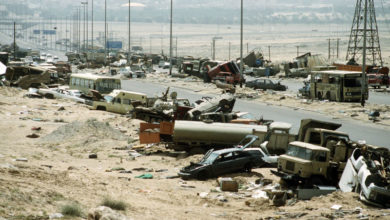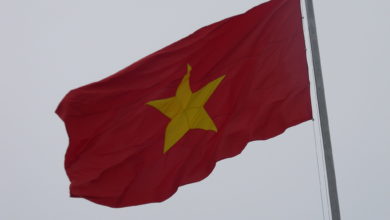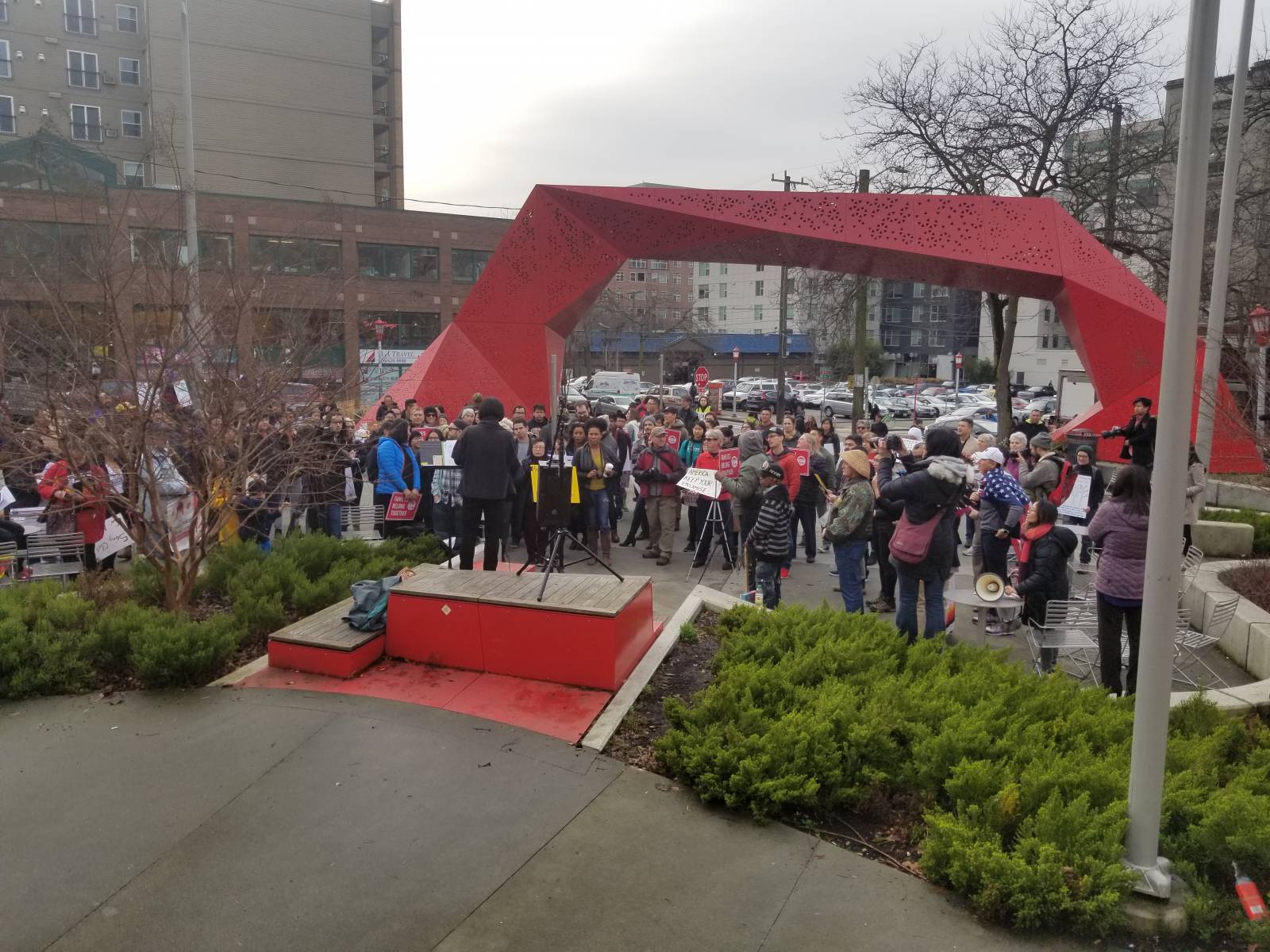 Ho Chi Minh City, 2005 Photo: Walter Teague |
Vietnam today enjoys the world’s second fastest economic growth rate after China, averaging 7.5 percent for the past five years. In the mid-1980s, an estimated 70 percent of the population lived in poverty. By 2002 the figure was down to 29 percent. This includes a dramatic decline in what the UN terms “extreme poverty.” By 2010, the World Bank estimates that the rate will be cut in half again.
According to Prime Minister Phan Van Khai, the goal is “to become an industrial country by 2020,” and not too long afterward to eliminate poverty entirely.
With a per capita national income of about $500, the country is still very poor by any standards. But according to the Communist Party of Vietnam, which is guiding economic growth, this figure will double by 2010.
Inflation, which was 700 percent 20 years ago, is under control and low, but it fluctuates. Food supplies are abundant. Foreign trade is rapidly expanding.
Today, Vietnam’s population is 83 million—more than double the 1975 population. That makes it the 14th most populous country in the world. Half the people are under the age of 25 with no direct memories of the war.
Ho Chi Minh City today is a vibrant municipality with many new buildings and construction projects. One inescapable sign of progress in a society that just two decades ago was experiencing catastrophic economic difficulties and hunger are the 3 million motorcycles said to navigate the city’s streets, making the crossing of certain thoroughfares an adventure.
While home to 6.6 percent of Vietnam’s people, the city creates over 20 percent of the country’s gross domestic product and is responsible for 30 percent of the industrial production and 40 percent of exports, while generating 32 percent of the state budget, according to Nguyen Minh Triet, secretary of the city’s Communist Party committee. It is also Vietnam’s scientific, information technology and cultural center, a destination for tourists from throughout the world and the location of the country’s first stock market. The government reports that no city resident lives below the annual poverty line of $200 per person.
Vietnam’s achievements are remarkable considering the unparalleled devastation it suffered from over 35 years of war against Japanese occupation (1940-45), French colonialism (1945-55) that was re-imposed after Japan was defeated, then U.S. imperialism.
In the U.S. war alone, Vietnam—about the size of New York State and Oklahoma combined—was the target of at least 8 million tons of bombs dropped from U.S. planes. Much of the country’s industrial and civilian infrastructure was leveled, and over 60 percent of the country’s villages and hamlets were decimated.
Farming communes were prime targets of the bombings. Hanoi and other large cities suffered serious damage. In the campaign to “bomb ’em back to the stone age,” as then Air Force Gen. Curtis LeMay postured, the United States let loose more bombs than all the tonnage dropped by all sides during World War II. Fortunately, Vietnam received considerable wartime aid from the socialist nations, primarily the USSR and China, which contributed to the country’s survival under horrendous circumstances.
Hostility didn’t end in 1975
The U.S. war against Vietnam didn’t end when President Richard Nixon was forced to withdraw the troops in 1973 or when the Pentagon-controlled southern puppet army collapsed in 1975. Washington continued hostilities by transforming its bombing war into almost 20 years of an economic and political war intended to prevent Vietnam from recovering.
During the Paris Peace Talks of 1973, Nixon promised Prime Minister Pham Van Dong in writing that the United States would pay Vietnam $3.5 billion in reparations. The Hanoi government counted on these reparations to help rebuild its shattered society. But the promise turned out to be worthless.
After Washington’s surrogate regime in Saigon disintegrated, the White House changed its trade rules so that any exports to Vietnam by U.S. companies or their subsidiaries abroad had to be approved by the State Department. This amounted to informal sanctions.
Next, the U.S. government instructed the World Bank—then headed by former Defense Secretary Robert McNamara—to suspend desperately needed agricultural grants for Vietnam. This influenced other international agencies to distance themselves from Hanoi’s postwar needs. In addition, Washington froze Hanoi’s assets in U.S. banks, some $70 million. This was pocket change for the U.S. government, but much-needed survival funds for Vietnam.
Worse, in February 1979, China invaded Vietnam. This unfortunate confrontation took place after Hanoi decided to march into Cambodia, China’s ally, to remove the Khmer Rouge from power after enduring repeated provocative military actions on Vietnamese soil.
The Chinese assault was pushed back fairly quickly by the powerful Vietnamese army, but not before China unleashed considerable destruction, adding to Vietnam’s economic woes. The United States, already in a tacit alliance with China against the Soviet Union and seeking one against Vietnam, subsequently tightened the economic screws on Hanoi.
Responding to U.S. wishes in 1979, Great Britain successfully pressured the European Community to halt its aid to Vietnam. That aid had consisted of sufficient milk shipments to nourish Vietnam’s children, since farm animals were killed in the wars and Hanoi had not yet been able to replace them.
Two years later, with Ronald Reagan in the White House, Washington banned U.S. humanitarian groups and agencies from sending any aid, not just to Vietnam but to socialist Laos and Cambodia as well, three poor countries that once constituted “French” Indochina. By now the sanctions were almost total.
A turn toward the market
By the mid-1980s, relations between Beijing and Hanoi were strained. The Soviet Union and the Eastern European socialist bloc were headed for collapse. Vietnam, which had hoped for aid in recovery from its two socialist wartime benefactors, faced a dreadful dilemma. Two five-year plans in a row had failed, putting a tremendous strain on the country’s newly collectivized land. Some feared everything they fought for would be lost.
After Chinese leader Mao Zedong’s death in 1976, the Chinese Communist Party moved sharply to the right, embracing a series of market reforms and exhorting the population to “get rich.” In the mid-1980s, the Communist Party of the Soviet Union embarked on the “perestroika” reforms, which also relied heavily on elements of the capitalist marketplace.
In this climate, the Communist Party of Vietnam leadership decided that the only way out of its crushing economic problem was to develop its own version of so-called market socialism. The decision to proceed in this direction was taken in 1986 after considerable struggle within the party. Opponents considered it a weakening of the foundations of a socialist society. I was told that echoes of these arguments within the CPV reverberated for years afterward, and may continue in some form today.
Vietnam’s called their reforms Doi Moi, usually translated as renovation. Implementation of the transition from a planned, state-owned socialist economy to what is today called “a multi-sector market economy with a socialist orientation under state management” began in stages nearly 20 years ago.
The Doi Moi model includes encouraging domestic and foreign private investment. State-owned and cooperatively owned sectors exist alongside the private sector. These state-supported businesses differ from socialist enterprises of the past. They operate with autonomy, compete among themselves and with the private sector, have their prices set by supply and demand, and compensate the state for its investment by paying taxes. Even with state planning, much of the socialist sector is beholden to market practices in many areas.
In some areas, it appears that Hanoi is investing more money to build up the state sector—a concrete indication, I was told, of continuing socialist intentions. Workers in state enterprises seem to earn better pay and benefits. Trade unions appear strong and defend worker rights in all sectors of the economy. There are also many popular mass organizations to exert pressure on the government and the CPV.
The CPV still stresses the goal of building a socialist society, despite the introduction of a private ownership and investment sector along with state-owned and cooperative sectors. It has identified in its 2001-2010 plan to “bring our country out of underdevelopment; improve noticeably the people’s material, cultural and spiritual life; and to lay the foundations for making ours basically a modern-oriented industrialized country by 2020.”
Nevertheless, the CPV recognizes that private property leads to economic inequality and to significant disparities between the wealthier urban areas and the poorer, more populous countryside. Nguyen Phu Trong of the CPV Central Committee’s Theoretical Council, notes that, “it is necessary to devise effective measures to limit negative phenomena of the market economy including pure profits, fierce competition, excessive exploitation and division between the rich and the poor.” Some such measures have and some have not yet been introduced.
Agriculture plays a major role in Vietnamese society, but it is now based on family units not collective or cooperative farms as in the past. Farm families lease their land on a long-term basis from the state and sell their products on the open market.
The dismantling of the state and cooperative farming sector is a significant departure from socialist methods, which emphasizes cooperative and communal forms of agricultural work as a way to boost both efficiency and solidarity with the urban working class. But the reforms have brought increased production in a society where hunger was a serious problem 20 years ago.
 Billboard celebrates the 30th anniversary of Vietnam’s liberation. Photo: Hoang Dinh Nam/AFP/Getty Images |
Doi Moi has managed to turn Vietnam, once utterly isolated, into a player in international trade. Vietnam now has a bilateral trade agreement with the United States, and it is a member of the Association of East Asian Nations and the ASEAN Free Trade Area. It is expected to join the World Trade Organization within the next one to two years, and the United States supports its membership. WTO membership will reduce the tariffs it must pay from up to 40 percent down to about 3 percent, making its products much easier to sell.
Where it once had hardly any exports, Vietnam now is the world’s second-largest exporter of rice. It also exports crude oil, corn, potatoes, tea, rubber, coffee, clothing, shoes, soybeans, electronics and computers.
The top five countries with capitalist investors are from Asia; France is number six. These countries are pressing Vietnam to make more concessions to the market, to reduce and get rid of the state (socialist) sector altogether, to harness the unions, to eliminate “red tape,” to reorganize its tariff and banking systems and so on.
The influential Economist magazine, while extolling Vietnam’s progress, complains that it is “addicted to public [socialist] enterprise.” Newsweek, likewise marveling at Vietnam’s comeback, simply cannot understand why it “clings” to socialism. Undoubtedly the international capitalist community will not feel totally secure about its increasing investments until Hanoi rids itself of the socialist portion of the economy.
Along with economic gains have come certain social setbacks. There are now built-in inequalities in the once extremely egalitarian socialist society. There are very few rich Vietnamese, so far, but there is a growing urban middle class with considerably more money to spend than the working class or workers and farmers in rural districts. There is also a degree of corruption in government and the ruling party, which the CPV acknowledges and is fighting against. It is acknowledged that some leading officials have enriched themselves over the years, and that bribery takes place at the medium levels in some instances.
Social services have been cut, but I was told that some that were cut in the early days of Doi Moi have been restored. Workers in foreign-owned and managed companies have a tougher time than workers in the state or cooperative sector. Urban unemployment and erratic employment exists, although the percentages are in dispute. And other ills associated with the capitalist societies—drug addiction, prostitution and organized crime—can now be found on the streets of Ho Chi Minh City.
A further problem is the potential for the erosion of socialist standards and ideology by the individualism and greed inextricably associated with a large injection of capitalism into socialist society. While the Communist Party firmly retains its leadership of the state and army, the growth of a capitalist class within the socialist-oriented society creates contradictions and sets the stage for increased class struggle.
Having said that, Vietnam continues to make important strides in social areas like education, health care and literacy. For example, the number of village health clinics far exceeds those of wealthier China, Thailand and Indonesia.
The returns on Vietnam’s experiments with development are not yet in—which the Vietnamese communists are the first to acknowledge. Many anti-imperialists and partisans of Vietnam’s future socialist development are concerned about the reliance on capitalist mechanisms on the road to socialism. That is not to minimize the enormous difficulties that Vietnam has faced as a poor country trying to develop after a devastating war in a hostile world environment.
Those of us who care about Vietnam—not only because of its incredible trials and triumphs of the modern era but because we wish to see the country prosper as a socialist society—can only watch the situation carefully and continue to express our solidarity for its goals of building socialism under extremely difficult conditions.
The author was among some 50 people from 20 countries invited by the Vietnamese government to participate in the anniversary ceremonies in Ho Chi Minh City commemorating the liberation of southern Vietnam that led to reunification. He was invited mainly for serving as editor of the Guardian, a United States weekly newspaper, throughout the war. The paper was a staunch supporter of the Vietnamese struggle for liberation and independence. Many of the facts in this article are based on discussions and presentations during the trip.




